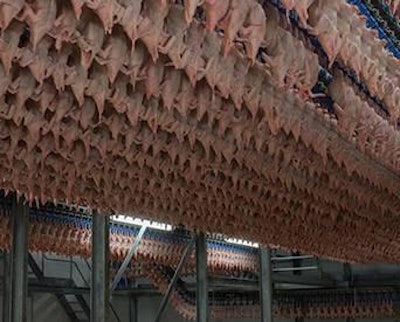
Cargill’s European chicken business is partway through a GBP35 million (US$55.6 million) expansion and modernization program, first announced in 2013, and implemented in response to growing demand for locally produced meat.
The investment is not only seeing Cargill’s capacity to process broilers expanded; it is also resulting in its operations performing more efficiently, and the investment is also having an impact on its local suppliers, as the processing facility is increasingly needing more birds from local poultry rearers.
The company’s European headquarters for the past 50 years has been in Hereford, UK, and it is there that the majority of the investment is being focused to create “one of the most efficient and competitive processing plants in Europe.”
The investment is being implemented in various stages, and Cargill took the opportunity of the opening of its new chiller operations to detail what has been achieved to date under its “Fresh Chicken” investment plan, initiated in November 2013, and which, when complete, will see the company’s processing capacity in the UK increase from 1.8 million birds a week to 2 million.
The Hereford site slaughters, cleans, chills and packages fresh chickens, as well as carrying out further processing to produce products for retail and restaurants.
More processed, better processed
The new chilling facilities, which came on stream in April 2015, can process up to 10,000 birds per hour and, in the future, more than 14,000 birds per hour - or 2 million birds each week, up from the previous capacity of 1.35 million.
The company can now chill carcasses more efficiently than before to a little above freezing, whereas previously it had only been able to bring temperatures down to 3.5C.
This will not only improve shelf life, but allows improved maturation by slowing rigor mortis.
Batches of birds enter the chiller 35 minutes post-slaughter, are cooled for approximately two and a quarter hours and then deboned. Total preparation time is about four and a half hours.
After de-feathering, the company plans to introduce electrostimulation technology which will massage and relax the birds before evisceration takes place and they will then be deboned straight from the chiller.
The Hereford processing plant modernization also has seen the introduction of state-of-the-art robotic and cutting technology to improve productivity, quality, efficiencies and safety, as well as the upgrading of the site’s reception facilities.
The upgraded reception area sees the need to handle birds reduced, which should help to keep them calm prior to slaughter.
Controlled atmosphere stunning
Controlled atmosphere stunning also has been adopted at the plant. Carbon dioxide is used to put the birds slowly to sleep, and this not only keeps chickens’ stress levels lower, but results in better meat quality and improved working conditions for employees, Cargill says. Birds are transported in their crates through a system that gradually replaces the oxygen in the environment with carbon dioxide. The dead birds are then removed from their crates and hung ready for processing.
Automated cutting and deboning technology is now used at the site, replacing manual deboning using knives. Up to 60 birds per minute can now be processed.
The company notes that it was the first in the U.K. to introduce robotic packaging, and can now process up to 240 breast fillets per minute. At the end of June, the processing plant also started using ultra-violet light finished pack decontamination technology in the packing area to provide an additional safeguard against any bacterial contamination that may be present.
The investment strategy has not, however, come to an end with the opening the chiller and other upgrades, and Cargill is now in the process of modernizing and expanding its evisceration activities. This is being carried out on the first floor of the building, rather than the ground. The new poultry processing plant layout brings into use an otherwise underutilized area of the building and allows production to continue while work is in progress.
The company notes that, once the area is live, it will be capable of running at higher speeds than the current evisceration operations, and with greater efficiency, so increasing capability. Because modern equipment is being installed, it will also be able to harvest additional products from birds that are not currently being used to their full potential.
Wider investment
The Fresh Chicken plan is not exclusively focused on the Hereford processing plant, and has also been used to increase chicken supply. The company’s hatchery has been expanded and can now hatch 2 million chicks per week which are then distributed to over farms that serve the Cargill business. More developments are also in the pipeline.
The decision to increase output has had a positive impact on the region’s broiler growers, as Cargill has needed to source more birds.
The company notes that it will only source birds from producers who are independently audited against comprehensive welfare standards and supported by the company’s field technical teams. All of the company’s sourced birds must be reared to Red Tractor Farm Assurance – a U.K. farm and quality food assurance scheme - standards.
In response to this increased demand, 11 new broiler farms are either being built or have been completed. The investments, following discussions with Cargill, are being made directly by farmers in Herefordshire and surrounding counties and the investment amount is thought to be close to GBP35 million.


















